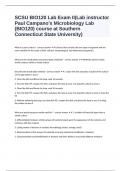Exam (elaborations)
SCSU BIO120 Lab Exam II(Lab instructor Paul Campano's Microbiology Lab (BIO120) course at Southern Connecticut State University) fully solved
- Course
- Institution
SCSU BIO120 Lab Exam II(Lab instructor Paul Campano's Microbiology Lab (BIO120) course at Southern Connecticut State University)
[Show more]



